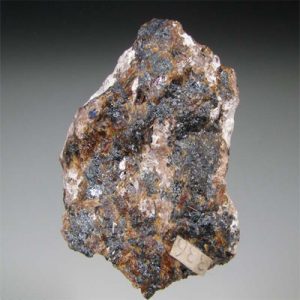Roeblingite
Roeblingite was first described in 1897 from an occurance at the Parker shaft of the Franklin Mine, Franklin, New Jersey, USA. It was named by its discoverers Samuel Lewis Penfield and Harry Ward Foote to honor of Colonel Washington A. Roebling (1837 – 1926), founder of the Mineralogical Society of America, engineer, inventor of the diving bell, builder of the Brooklyn Bridge, and avid mineral collector. Roebling donated his extensive mineral collection to the Smithsonian Institution.
Roeblingite was among the first of the lead silicate minerals found at Franklin, many of which are known only from Franklin and from Långban, Värmland, Sweden, the only other location where Roeblingite can be found. Roeblingite is valued for its rarity, its discovery at the Franklin Mine and its fluorescent properties. It fluoresces dull red to orange-red under shortwave UV light.
| Chemical Formula: | Pb2Ca6Mn2+Si6O18(SO4)2(OH)2 • 4(H2O) |
| Hydrated Lead Calcium Manganese Silicate Sulfate Hydroxide | |
| Molecular Weight: | 1,409.57 gm |
| Composition: | Calcium | 17.06 % | Ca | 23.87 % | CaO |
| Silicon | 11.95 % | Si | 25.58 % | SiO2 | |
| Hydrogen | 0.72 % | H | 6.39 % | H2O | |
| Lead | 29.40 % | Pb | 31.67 % | PbO | |
| Sulfur | 4.55 % | S | 11.36 % | SO3 | |
| Oxygen | 36.32 % | O | |||
| 100.00 % | 98.86 % | = TOTAL OXIDE |
| Crystallography: | Monoclinic – Prismatic |
| Crystal Habit: | As dense, compact, very fine grained masses of tiny lathlike crystals, which may be in parallel growth; as platy aggregates. |
| Twinning: | None |
| Cleavage: | Perfect on {001} |
| Fracture: | Fibrous |
| Tenacity: | Brittle |
| Moh’s Hardness: | 3.0 |
| Density: | 3.443 (g/cm3) |
| Luminescence: | Fluoresces dull red to dull orange-red under SW UV. |
| Radioactivity: | Not Radioactive |
| Health Warning: | CAUTION: Contains Lead – always wash hands after handling. Avoid inhaling dust when handling or breaking. Do not lick or ingest. |
| Color: | White to pale pink; colorless in thin section |
| Transparency: | Transparent, Opaque |
| Luster: | Dull to somewhat resinous. General appearance is porcelanous. |
| Refractive Index: | 1.640 – 1.660 Biaxial ( + ) |
| Birefringence: | 0.020 |
| Dispersion: | Relatively weak; r < v |
| Pleochroism: | None |


